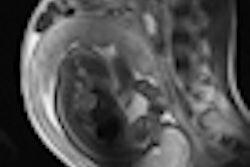CHICAGO - The use of low-dose CT pulmonary angiography (CTPA) to rule out suspected pulmonary embolism (PE) -- the leading cause of death during pregnancy -- works just as well as a standard-dose protocol, researchers from Boston reported Monday.
The low-dose scan yielded equivalent image quality and vessel enhancement at a fraction of the standard dose, a team from Beth Israel Deaconess Medical Center concluded in its study.
The high incidence of PE in this population "is partly explained by an increase in clotting factors and a decrease in natural anticoagulants" during pregnancy, explained principal investigator Dr. Diana Litmanovich in a presentation at the 2007 RSNA meeting.
"For the general population, CTPA is a well-known first-line study for the evaluation of pulmonary embolism," and the most common test in use in ruling out PE in pregnancy today, according to a survey by the Society of Thoracic Radiology, she said.
However necessary the test may be, radiation dose is a concern during pregnancy, and there are no specific guidelines for CTPA dose reduction during pregnancy or studies comparing the value of reduced-dose CTPA exams, Litmanovich said.
With this in mind, the group developed a low-dose CTPA protocol incorporating reduced mAs, kVp, and shortened anatomic coverage for use in pregnant women with suspicion of pulmonary embolism (PE), and compared the image quality to the results of standard-protocol CTPA in another group of women.
The study included 15 pregnant women (age 21-40 years [28 ± 6]) at five- to 38-weeks gestation (17 ± 8) with suspected PE. They were imaged using a low-dose protocol that consisted of 200 mAs and 100 kVp, and scanned from the aortic arch to the diaphragm on a 64-detector-row CT scanner.
A similar control group of 15 nonpregnant female patients (age 21-40 years [32 ± 6]) who underwent the standard-dose exam during the same time period were identified retrospectively. The standard protocol included 400 mAs, 200 kVp, and coverage of the entire thorax. All patients also underwent Doppler ultrasound evaluation before proceeding to CTPA if the results were negative.
The low-dose protocol incorporated automatic bolus triggering, a standard 15-second scan delay, and injection of 4-6 mL/sec of iodinated contrast medium, Litmanovich said.
To compare the datasets, the researchers measured attenuation of the pulmonary arteries at predetermined points. Two radiologists working independently, and blinded to the results, evaluated and graded image quality for assessment of acute pulmonary artery disease on a five-point scale ranging from 1 (nondiagnostic) to 5 (excellent image quality). Finally, dose-length product (DLP) and CT dose index (CTDI) measurements of radiation dose were measured in a subset of patients, Litmanovich said.
According to the results, CTPA was diagnostic at the level of segmental pulmonary arteries in all patients (score 3 or higher) and at the level of subsegmental arteries (score 4 or 5) in 12 (80%) of the pregnant patients, compared to 13 (87%) of the controls, with no statistically significant difference between the groups, Litmanovich said.
"Vessel enhancement was high and homogeneous in both groups at all measured levels, with no significant difference between the levels of enhancement and with the mean enhancement of 290 HU," she said. Mean main and lobar pulmonary enhancement values were 327 ± 58 and 307 ± 87 HU, respectively, and there was no significant difference from the matched controls (330 ± 42 HU and 320 ± 55 HU, respectively).
The median ranks of confidence for excluding PE in segmental and subsegmental pulmonary arteries were 5 and 4 (quartiles 4.75-5 and 4-5, respectively) compared to 5 and 5, respectively, for controls (p > 0.05), the group wrote in an abstract. The mean DLP in pregnant patients was 161 ± 59 mGy-cm compared to 598 ± 32 mGy-cm in matched controls (p < 0.001), a fourfold dose reduction. The radiologists noted increased image noise in images produced by the reduced-dose technique.
"The dose-length product was decreased by a factor of four, and this was achieved not only by the decrease in the (anatomic coverage) of the study, but also by the significant decrease of the CT dose index, which was also reduced by a factor of four," Litmanovich said.
"The modified protocol demonstrated comparable vessel enhancement and comparable image quality, with a fourfold decrease in dose-length product and CTDI," she concluded. "The major limitation of our study was the absence of positive PE in presentation." Fortunately, follow-up showed no pulmonary embolism or unexplained deaths, she added.
The group is testing the new protocol in a larger multicenter trial setting, Litmanovich said in response to a question from the audience. If the results are successful, she said, the group may implement the low-dose protocol in nonpregnant women as well.
By Eric Barnes
AuntMinnie.com staff writer
November 27, 2007
Related Reading
V/Q scan finding reliably excludes pulmonary embolism, September 28, 2007
Researchers scrutinize CTA for pulmonary embolism, July 16, 2007
CAD shows promise in tumor detection with PET, June 5, 2007
Duke researchers combine DR tomosynthesis with 3D CAD, June 4, 2007
Divergent research on CT lung screening sparks more debate, fewer answers, April 19, 2007
Copyright © 2007 AuntMinnie.com




















